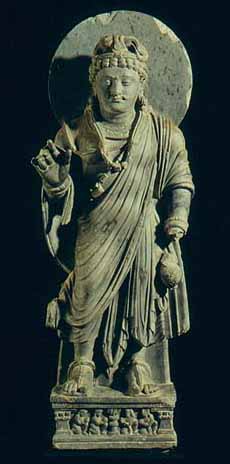

�Maitreya Bodhisattva (Sanskrit) or Metteyya Bodhisatta is the future Buddha in Buddhist eschatology. Maitreya is a bodhisattva who some Buddhists believe will eventually appear on earth, achieve complete enlightenment, and teach the pure dharma. Maitreya Bodhisattva will be the successor of the historic Sakyamuni Buddha. He is predicted to be a world-ruler, uniting those who he rules over. The prophecy of the arrival of Maitreya is found in the canonical literature of all Buddhist sects (Theravada, Mahayana, Tantrayana, Navayana, Purnayana, Triyana and Vajrayana) and is accepted by most Buddhists as a statement about an actual event that will take place in the distant future.
Maitreya is typically pictured seated, with both feet on the ground, indicating that he has not yet completed ascending his throne, which is believed to be a style of western throne, not Indian as previously believed. He is dressed in the clothes of either a Bhiksu or Indian royalty. As a Bodhisattva, he would usually be standing, and dressed in jewels. Usually he wears a small stupa in his headdress, and could be holding a chakra wheel resting a lotus. A scarf is always tied around his waist. In the Greco-Buddhist art of Gandhara, in the first centuries AD in northern India, Maitreya is represented as a Central Asian or northern Indian nobleman, holding a water phial in his left hand. He is flanked by his two acolytes, Asanga and his brother, Vasubandhu.
Maitreya's coming coincides with a new school of teaching to surpass that of the original Gautama Buddha. Maitreya is predicted to attain Bodhi in seven days (which is the minimum period), by virtue of his many lives of preparation for Buddha-hood (similar to those reported in the Jataka stories of Shakyamuni Buddha).
Maitreya's coming is characterized by a number of physical events. The oceans are predicted to decrease in size, allowing Maitreya to traverse them freely. The event will also allow the unveiling of the true dharma to the people, in turn allowing the construction of a new world. The coming also signifies the end of the middle time in which humans currently reside (characterized as a low point of human existence between the Gautama Buddha and Maitreya).
In order for the world to realize the coming of Maitreya, a number of conditions must be fulfilled. Gifts should be given to Buddhist monks, moral precepts must be followed, and offerings must be made at shrines.Some of the events foretold at the coming of the second Buddha include an end to death, warfare, famine, and disease, as well as the ushering in of a new society of tolerance and love.
The name Maitreya or Metteyya is derived from the word maitri (Sanskrit) or metta meaning "loving-kindness", which is in turn derived from the noun mitra in the sense of "friend". Maitreya, who is sometimes represented seated on a throne Western-style, and venerated both in Mahayana and non-Mahayana Buddhism, is sometimes considered to have been influenced by the Zoroastrian Mithra, a god of contracts, associated with the Sun. The primary resemblance between the two characters appears to be the chance similarity of their names.
Paul Williams claims that some Zoroastrian ideas influenced the cult of Maitreya, such as "expectations of a heavenly helper, the need to opt for positive righteousness, the future millennium, and universal salvation". Possible objections are that these characteristics are not unique to Zoroastrianism, nor are they necessarily characteristic of the belief in Maitreya.
In the Greco-Buddhist art of Gandhara, in the first centuries CE in northern India, Maitreya was the most popular figure to be represented, together with the Buddha.
In China, the cult of Maitreya seems to have developed earlier than that of Amitabha, as early as the 3rd century AD.
Maitreya Wikipedia